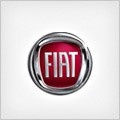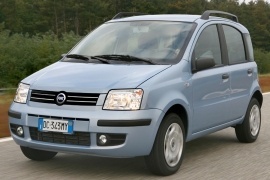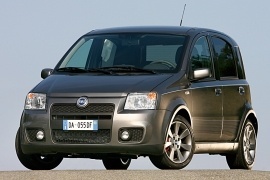
FIAT Panda
Generations Timeline, Specs and Pictures

The Fiat’s success with the Panda started back in 1980 and since then, the company produced over 2 million Pandas and the number kept growing with every new generation.
In 2011, Fiat decided to revive the Panda and give it a more mature look, but with the same versatility displayed by the previous models.
Fiat has thus launched a replacement in the form of the new Panda, which made its debut at this year’s Frankfurt Auto Show.
The Panda was offered with 3 engine options: a 0.9-liter aspirated TwinAir developing 65 hp, a 1.2-liter Fire Evo II (optimized valve timing at all engine speed and ensure higher torque) with 69 hp and a 1.3-liter Multijet with 75 hp.
The gasoline engines and the 1.3-liter multijet offered a Start&Stop system as standard, which reduced the fuel consumption and the CO2 emissions.
Even if the Panda was a small car, its trunk was still very spacious and could comfortably accommodate 5 people. The load area could go up to 260 liters with the rear seats folded. Another smart thing was the thin front seats that ensure enough legroom for the rear seats passengers.
At the launch, the Panda was offered with a two-wheel-drive, however, later on, a Panda 4x4 was presented to the public.

After 22 years on the market and 4.5 million units sold, the first generation of the Panda was pulled out from the production lines and made room for its successor, the 2003 Panda.
The first Panda generation was nothing more than a box on wheels. It was cheap to buy, easy to run, and reliable. But in 2003, it was way too old and outdated. Fiat worked together with Ford and developed a new platform, which was used for the 500, the Ka’s second generation, and the Panda.
Looking tall but still with flat side panels, the second generation of the Panda featured squared headlights and a narrow, two-slat grille between them. Depending on the trim option, Fiat installed a pair of fog lights on the bumper’s sides and a wide grille between them. From its sides, the designers made an unusual window line, with a sloped-down area on the rear doors and a smaller, third glass, between the C- and D-pillars. The vertical drop in the back for the tailgate was a form-follow-function measure.
Inside, Fiat installed high-mounted seats with a rounded dashboard design. The carmaker installed the gear-stick on the center stack, while the instrument panel looked very similar to the one on the Fiat Punto, but with a different cluster above it. The carmaker promised and delivered room for four adults. The rear bench was too cramped for three adults but adequate for three kids.
Under the hood, Fiat offered a choice of four engines paired exclusively with a five-speed manual.

The Panda was already a successful model, and Fiat tried to transform it into a city-segment hot-hatch in 2006 when it granted it with a special version: the Panda 100HP.
The Panda 100 was the car that proved that Fiat could build emotional vehicles in any segment. The Italian carmaker transformed an otherwise bland vehicle into a sporty hot-hatch.
On the outside, the design team tuned the car and gave it a new front bumper with an aggressive black rectangular grille at the front. Later on, another carmaker made something similar and registered the singleframe name for that. On the lower side, the designers installed fog lamps on the outers side, in mesh-grille fake vents. From its sides, the Panda 100 exposed its 15” light-alloy wheels. Its wheel-arches were adorned with black plastic moldings. To complete the sporty image, a small wing was added at the top of the tailgate while the engineers decreased the ground clearance and stiffened the suspension.
Inside it was the same Panda as before but fitted with two-tone sport high-bolstered bucket-seats. Since it was the full-options versions, Fiat installed every option from its book, including an automatic climate control system, an on-board computer and an in-dash 6-CD changer. Last but not least, it installed buttons on the steering wheel.
Under the hood, Fiat introduced an upgraded version of the 1.4-liter turbocharged gasoline engine. It was pushed to provide 100 hp paired as standard to a 6-speed manual gearbox.

The first facelift variant of the Panda introduced in 1980 was released in 1986.
The Panda received both technical and visual revisions. The rear suspension was upgraded, the car’s body was strengthened and galvanized to avoid rust. The biggest upgrade was represented by the transition from the air-cooled two-cylinder engines to water-cooled four-cylinder ones.
A van variant was also introduced in the same year, available until 1994, fitted with two engine variants, gasoline or diesel. The rear seats were ditched and the rear windows were replaced by plastic blanking panels. The diesel and the van versions were not produced for right hand markets.
Fiat introduced two new engines: a 769cc producing 34 HP and a 999cc with 45 HP or 50 HP for the 4x4 variant. In mid 1986, the Panda received a 1301cc diesel engine producing 37 HP, paired with a 5-speed gearbox.
In 1986, four Fiat Panda variants were available: 750 L, 1000 4x4, 1000S and 1000CL. In 1990, Fiat also released released a two-seater version called the Panda Elettra – its name coming from the all-electric powertrain that was added. The batteries were placed where the rear seats used to be. The Elettra was significantly heavier than the ICE-powered Panda, adding 450 kg, so the suspension and brakes were modified to cope with the extra weight of the batteries. That said, the Elettra was considered a commercial failure and was discontinued in 1998.

Back in the late 70’s, the CEO of Fiat, Carlo de Benedetti, asked Giorgetto Giugiaro from the newly founded Italdesign to design a small car to replace the Fiat 126.
While Giurgetto worked on the design of the small Panda, Aldo Mantovani focused on the mechanicals.
The requirements were clear: the manufacturing costs needed to be low, while the car had to be spacious and practical, just like the rival Renault 4.
During the designing process, Giugiaro conceived the seats of the new model inspired from a folding lounge chair, as they were inexpensive to manufacture, simple and easy to maintain. The trunk needed to be big enough to accommodate two 50-liter carboys.
The project was based on a monocoque construction with a nearly flat floor, to ensure a roomy cabin.
Before the final version, Italdesign presented no less than two full-scale models and 4 different side designs. The pre-production prototypes were test-marketed at an unpublicised event where the participants were impressed by the car’s design and practicality.
The first generation of Fiat Panda was launched to the press in 1979 and unveiled to the public in 1980. The then-new Panda was a departure from Fiat’s models, featuring a front-wheel-drive system instead of the old rear-wheel drive one.
The Panda had a boxy utilitarian design, with an asymmetrical font grille that was fitted differently depending on the engine, as two different models were available: Panda 30 powered by a 652 cc engine and the Panda 45 with an engine displacement of 903 cc.
Inside, besides the rudimentary design, the cabin was fitted with a highly flexible interior. The rear seat was adjustable in 7 different ways and could be folded flat into a provisional bed. The interior mirror was simple, with no day and night adjustments.
The instrument cluster featured a heating vent, however, the small Panda was not equipped with dash outlets for fresh air. Instead, the side windows had vent windows and optional pop-out rear windows.























































